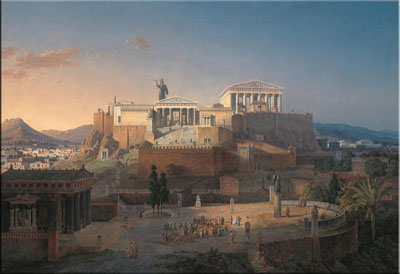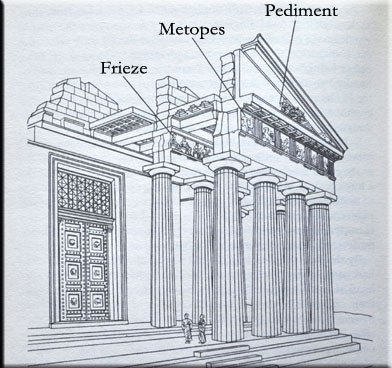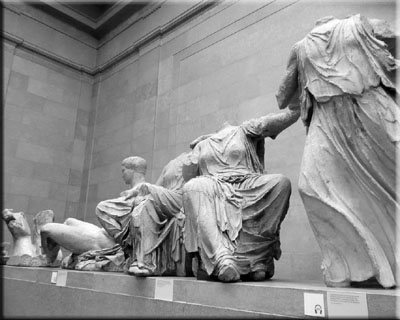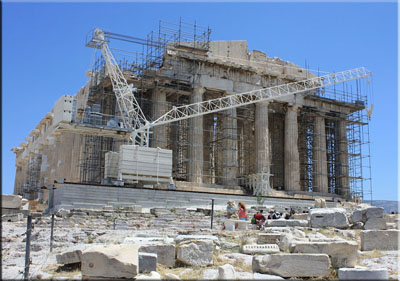In 1799 a Scottish nobleman named Robert Bruce, the 7th Earl of Elgin, was appointed as the British ambassador to the Ottoman Empire in Constantinople. While serving as ambassador, Lord Elgin managed to obtain some of the most important marble scultpures from the Parthenon in Athens and ship them back to Britian. Almost ever since, Greece has tried to get back the “Elgin Marbles” and the British have refused to return them.
 The Parthenon is the best-known Classical Greek structure on the Acropolis, a steep-sided hill in the center of Athens. It was built from 447 to 438 BC of marble quarried on nearby Mount Pentelikos. The Parthenon was a temple to the goddess Athena from its construction until the forth century AD. With the spread of christianity, the Parthenon became a Christian Church from the forth century until 1448 when Athens was conquered by the Ottoman empire. Thereafter, the Ottomans used the Parthenon as a mosque and defensive garrison. After the Greek revolution in 1828, most of the Christian and Ottoman additions and modifications were removed although damage continued.
The Parthenon is the best-known Classical Greek structure on the Acropolis, a steep-sided hill in the center of Athens. It was built from 447 to 438 BC of marble quarried on nearby Mount Pentelikos. The Parthenon was a temple to the goddess Athena from its construction until the forth century AD. With the spread of christianity, the Parthenon became a Christian Church from the forth century until 1448 when Athens was conquered by the Ottoman empire. Thereafter, the Ottomans used the Parthenon as a mosque and defensive garrison. After the Greek revolution in 1828, most of the Christian and Ottoman additions and modifications were removed although damage continued.
 Although it was modified by both the Christians and later by the Muslims (Ottomans), the overall structure of the Parthenon survived mostly intact for over 2000 years. However, it was damaged extensively in the two centuries prior to Lord Elgin’s arrival in 1799. The worst damage was done in 1688 when the Venetian army attacked Turkish forces on the Acropolis. The Turkish army was using the Parthenon as a defensive stronghold to protect both people and arms. In 1688 attack, a Venetian cannonball struck a cache of gunpowder stored in the Parthenon. The resulting explosion blew out 28 columns of the Parthenon and killed 300 people.
Although it was modified by both the Christians and later by the Muslims (Ottomans), the overall structure of the Parthenon survived mostly intact for over 2000 years. However, it was damaged extensively in the two centuries prior to Lord Elgin’s arrival in 1799. The worst damage was done in 1688 when the Venetian army attacked Turkish forces on the Acropolis. The Turkish army was using the Parthenon as a defensive stronghold to protect both people and arms. In 1688 attack, a Venetian cannonball struck a cache of gunpowder stored in the Parthenon. The resulting explosion blew out 28 columns of the Parthenon and killed 300 people.
 While ambassador to the Ottoman Empire in 1801, Elgin managed to get two vague and ambiguously written “firmans” (written official permissions) from the ruling Turks to “measure, sketch, and make plaster molds” and later to take “blocks of stone having inscriptions or figures upon them”. Going far beyond what was actually written in the firmans, Lord Elgin’s agents eventually removed 18 pedimental sculptures, 15 metopes, and 56 blocks of the freize. They also removed many marble sculptures and fragments from other structures on the Acropolis. These “marbles” were crated and shipped back to England from 1801 to 1806.
While ambassador to the Ottoman Empire in 1801, Elgin managed to get two vague and ambiguously written “firmans” (written official permissions) from the ruling Turks to “measure, sketch, and make plaster molds” and later to take “blocks of stone having inscriptions or figures upon them”. Going far beyond what was actually written in the firmans, Lord Elgin’s agents eventually removed 18 pedimental sculptures, 15 metopes, and 56 blocks of the freize. They also removed many marble sculptures and fragments from other structures on the Acropolis. These “marbles” were crated and shipped back to England from 1801 to 1806.
During a brief peace between England and France, Elgin tried to return to England in 1803. Unfortunately, he did so by traveling through France. While in France, war was again declared and Elgin was held for nearly 3 years as a prisoner of war.
 Lord Elgin was finally able to return to England in 1806. After having spent a fortune of his wife’s family money and incurring enormous debts of his own removing and shipping the marbles back to England, Elgin was nearly bankrupt. After years of negotiations, Elgin agreed to sell the marbles to the British Museum in 1816. Elgin estimated his total costs at about £74,000. The price Elgin got (£35,000) was less than half his actual costs and almost all of it went directly to his creditors. The marbles have remained in the British Museum ever since.
Lord Elgin was finally able to return to England in 1806. After having spent a fortune of his wife’s family money and incurring enormous debts of his own removing and shipping the marbles back to England, Elgin was nearly bankrupt. After years of negotiations, Elgin agreed to sell the marbles to the British Museum in 1816. Elgin estimated his total costs at about £74,000. The price Elgin got (£35,000) was less than half his actual costs and almost all of it went directly to his creditors. The marbles have remained in the British Museum ever since.
 In 2010 Greece completed a restoration of the Parthenon and has built the Acropolis Museum to house, among other things, the sculptures removed by Lord Elgin. Greece and others have put enormous pressure on the British to return the “Parthenon Marbles”. So far the British Museum has maintained that Lord Elgin aquired the marbles legally and refuses to return them. We will see how long can the British can hold out.
In 2010 Greece completed a restoration of the Parthenon and has built the Acropolis Museum to house, among other things, the sculptures removed by Lord Elgin. Greece and others have put enormous pressure on the British to return the “Parthenon Marbles”. So far the British Museum has maintained that Lord Elgin aquired the marbles legally and refuses to return them. We will see how long can the British can hold out.

